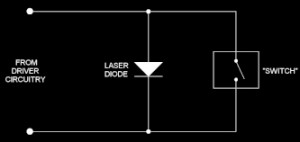ESD polarity terminology used on this web site
The term “positive-ESD” is used to mean electrostatic discharge (ESD) whose voltage polarity would tend to forward-bias a laser diode. “Negative-ESD,” means ESD whose voltage polarity would tend to reverse-bias a laser diode.
|
Review of ESD approaches |
||||
| START | PREV | CURRENT | NEXT | END |
|
Introduction << |
||||
Review of ESD approaches
Switch, relay or MOSFET used as an ESD protection means
 The figure to the right shows another approach commonly employed to protect a laser diode from ESD. In this approach a “switch” is used, and placed across the terminals of the laser diode.
The figure to the right shows another approach commonly employed to protect a laser diode from ESD. In this approach a “switch” is used, and placed across the terminals of the laser diode.
This “switch” is often implemented as a relay, but implementations are known in which this “switch” is implemented as a depletion-mode MOSFET. The idea is that this “switch” would be “normally closed”; that is, while no power is applied to the laser diode or laser diode driver circuitry, the “switch” shorts the terminals of the laser diode such that ESD is conducted by the “switch” rather than the laser diode.
Having an ESD protection means that is effective when no power is applied to the system is indeed desirable, because very often, ESD events happen while the system power is turned off.
However, this “switch” approach has several important drawbacks, which will be discussed separately for the case of the relay and for the depletion-mode MOSFET.
Relay drawbacks
As discussed, the impedance of any passive technique would need to be less than 44 milliohms in order to be effective in preventing a 15,000-volt ESD event from exceeding the typical 2-volt maximum reverse-bias voltage and similar forward-bias limitations of a typical low-power laser diode. If this “switch” is implemented as a relay, throughout the life of the relay, the contact resistance, along with any PCB traces and other interconnections that lead from the relay to the laser diode, need to be collectively less than 44 milliohms. As relays open and close over and over during their lifetime, their contacts wear, and it is possible that as the relay ages, the contact resistance plus interconnect resistance could exceed 44 milliohms.
Moreover, during an ESD event in which the relay is closed, up to 50 amps or more could be conducted by the relay contacts. Repeated ESD events could lead to fretting corrosion of the relay contacts, and eventual failure of the relay.
Moreover, during an ESD event, a magnetic field is set up around the relatively long leads within the relay geometry, along with the contacts themselves. This magnetic field could couple to nearby PCB traces, and to the relay coil, effectively coupling the ESD to other parts of the circuit that could also be sensitive to ESD. Thus, even if the laser diode itself were protected, ESD could prove destructive to the laser diode drive circuitry.
MOSFET drawbacks
When a depletion-mode MOSFET is used as the “switch” and when the power is off, the gate and source terminals are at the same (zero) voltage potential. This turns a depletion-mode MOSFET “on,” thus helping to conduct ESD across the terminals of the MOSFET instead of the laser diode. Unfortunately, the typical on-resistance of a depletion-mode MOSFET is in the range of several ohms.
An exemplary device has a RDS(on) of 6 ohms. As discussed, this resistance would need to be less than 44 milliohms in order to protect a typical laser diode from a 15,000-volt ESD event. Thus, a depletion-mode MOSFET would not be an effective ESD protection means for 15,000-volt ESD events.
“Switch” drawbacks
Whether the “switch” is implemented as a relay, MOSFET, or some other device, there is another drawback to this approach. The “switch” approach is generally applicable to systems whose power is turned off. Once the system power is turned on, the switch is opened and the laser diode is allowed to become operational. If an ESD event happens while the laser diode is operational and lasing, the “switch” will have no effect, and will not protect the laser diode from ESD.

